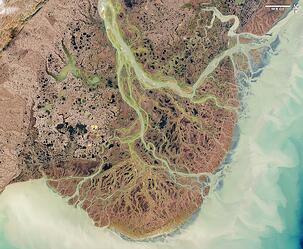While the NASA rover Curiosity explores the Martian surface, researchers from Washington University at St. Louis (WUSTL) are working behind the scenes, exploring the data that the rover sends back. WUSTL researchers also played a large part in getting Curiosity off the ground, literally.
Curiosity is the fourth rover to land on Mars. Its most recent predecessors, Spirit and Opportunity, arrived in 2004 with the goal of finding evidence of water on Mars. While no liquid water turned up, the mission concluded that Mars' past was considerably more wet than its present. The greatest indicator for a watery surface is the terrain: it has features that don't resemble seismic activity or impact craters. For instance, the Martian landscape pictured left looks quite similar to the Yukon Delta, right:
 |
 |
It certainly looks like Mars was once home to not only water, but liquid running water at that. Where did all this water go?
The answer lies on our home planet. Earth currently orbits the sun at a certain distance, called the habitable zone. Basically, this is the range at which a planet can orbit the Sun without being too far away (making it unbearably cold) or too close (making it scorchingly hot). While Mars is currently outside the habitable zone, it was likely within it in the past, allowing liquid water to flow and leave the marks that we see today.
By this point, you may be wondering what all this has to do with life science. Well, it's called the habitable zone for a reason: planets at that distance can not only sustain running water, but also the beginnings of life. Spirit and Opportunity paved the way for Curiosity, whose mission is to discover evidence of past or present life on Mars.
Raymond Arvidson, a Washington University professor who was also the former chair of the Department of Earth & Planetary Sciences, is NASA's Mars Exploration Rover Mission deputy principal investigator. Many St. Louis graduates join him in key roles for the mission. One such researcher is Bethany Elhmann, whose role in the mission is to operate the Chemistry and Camera ("ChemCam") tool aboard Curiosity. ChemCam is much more than the average camera: it fires a laser at its target sample in order to analyze it. Here's an artist's rendition of what that would look like on Mars.

Image Courtesy of Curiosity's Twitter Feed
The laser vaporizes the rock sample, turning it into plasma. At the plasma level, each element gives off a certain spectrum of light. Curiosity is armed with a spectrometer that can analyze these spectra and determine the ratio of elements in the sample. This can help determine whether water was flowing past or resting on certain rocks in the past. Another thing Curiosity searches for is organic compounds that would point to the existence of life. Elhmann comments on the possibility in a recent Washington University article:
"It would be a grand-slam home run if we find enhanced carbonates, particularly organic carbon, because that could tell us that Mars might even have been inhabited long, long ago."
Another WUSTL member of Curiosity's research team, Jeff Marlow, studies life at its extreme in order to better understand the limits of life. He's researched such extreme locations as acidic rivers, Antarctic caves, and the deep ocean to see what kind of life forms can survive there. Studying these organisms gives us a better idea of what to expect if we do find traces of life on the Martian surface. Marlow is a writer for Wired magazine and The New York Times as well; his writing skills are apparent in his stellar posts to NASA's Martian Diaries, a blog that tracks the Curiosity mission a day to day basis. He is also a capable public speaker: in a recent TEDx talk at Caltech, Marlow explains the importance of exploration. He cites the moon landing as one of the only landmark events in American history that was truly positive, and makes the case for exploration as a social benefit:
“As the settlers of Easter Island showed us, exploration is in our roots. It’s a uniquely human characteristic that has produced some of the most important unifying, positive moments in history, and I believe that the discovery of life on Mars, if it were to happen, would be a similarly profound moment. These moments bring people together and change what it means to be human, and that is why we explore.”
Marlow, Ehlmann, and Arvidson are all researchers with Washington University at St. Louis, where Biotechnology Calendar will be holding its St. Louis BioResearch Product Faire™ in 2013. Biotechnology Calendar produces top-tier scientific tradeshow events that allow university researchers to meet and network with representative of cutting-edge laboratory supply and technology companies to learn about the latest products in their field. If this article has sparked your curiosity, please have a look at our 2012 schedule and 2013 schedule. For more information on WUSTL funding, click the button below:


